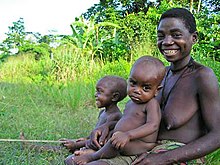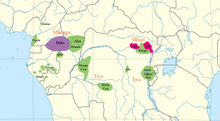Pygmy peoples
ethnic group whose average height is unusually short
In anthropology, pygmy peoples are ethnic groups whose average height is unusually short. The term pygmyism is used to describe the phenotype of endemic short stature (as opposed to disproportionate dwarfism occurring in isolated cases in a population) for populations in which adult men are on average less than 150 cm (4 ft 11 in) tall. The term is primarily associated with the African Pygmies, the hunter-gatherers of the Congo basin (comprising the Bambenga, Bambuti and Batwa).



Quotes
edit- African Pygmies speak languages belonging to either the Nilo-Saharan or the Niger–Kordofanian family. It is assumed that Pygmies once spoke their own language(s), but that, through living in symbiosis with other Africans, in prehistorical times, they adopted languages belonging to these two families.
- Ruhlen, Merritt (1994) The Origin of Language: Tracing the Evolution of the Mother Tongue. John Wiley & Sons, Inc: New York, p. 154, ISBN 0471584266.
- The short stature of Pygmy groups around the world has long intrigued anthropologists. It is generally accepted that their small body size is a result of genetic adaptation; however, which genes were selected, and the nature of the underlying selective force(s), remain unknown. The various hypotheses proposed include adaptations to food limitation, thermoregulation, mobility in the forest, and/or short lifespan. A recent study of the HGDP-CEPH populations identified a signal of selection in the insulin growth factor signalling pathway in Biaka Pygmies, which might be associated with short stature, but this signal was not shared with Mbuti Pygmies. By contrast, we found strong signals for selection in both African Pygmy groups at two genes involved in the iodide-dependent thyroid hormone pathway: TRIP4 in Mbuti Pygmies; and IYD in Biaka Pygmies (Fig. 7). Intriguingly, a previous study found a significantly lower frequency of goiter in Efe Pygmies (9.4%) than in Lese Bantu farmers (42.9%). The Efe and Lese live in close proximity to one another in the iodine-deficient Ituri Forest and share similar diets. Moreover, the frequency of goiter in Efe women living in Bantu villages was similar to that of Efe women living in the forest, and the frequency of goiter in offspring with an Efe mother and a Lese father was intermediate between that of Efe and Lese. These observations suggest that the Efe have adapted genetically to an iodine-deficient diet; we suggest that the signals of recent positive selection that we observe at TRIP4 in Mbuti Pygmies and IYD in Biaka Pygmies may reflect such genetic adaptations to an iodine-deficient diet. Furthermore, alterations in the thyroid hormone pathway can cause short stature. We therefore suggest that short stature in these Pygmy groups may have arisen as a consequence of genetic alterations in the thyroid hormone pathway. If this scenario is true, then there are two important implications. First, this would suggest that short stature was not selected for directly in the ancestors of Pygmy groups, but rather arose as an indirect consequence of selection in response to an iodine-deficient diet. Second, since different genes in the thyroid hormone pathway show signals of selection in Mbuti vs. Biaka Pygmies, this would suggest that short stature arose independently in the ancestors of Mbuti and Biaka Pygmies, and not in a common ancestral population. Moreover, most Pygmy-like groups around the world dwell in tropical forests, and hence are likely to have iodine-deficient diets. The possibility that independent adaptations to an iodine-deficient diet might therefore have contributed to the convergent evolution of the short stature phenotype in Pygmy-like groups around the world deserves further investigation.
- Price AL, Tandon A, Patterson N, Barnes KC, Rafaels N, Ruczinski I, Beaty TH, Mathias R, Reich D, Myers S (2009). "Sensitive Detection of Chromosomal Segments of Distinct Ancestry in Admixed Populations".
Pygmies in the Congo Free state
edit- If we make a village here it is good. If we make it in another place it is just as good.
- Life among the pygmies of the Ituri forest, Congo Free State, Page 22. When hunting in the forrests of the Congo Free State and they kill an extra big animal, and the chief is not with them, they do not touch it till his arrival, when he decides whether to move the animal to the village or the village to the animal. This is the chorus they are very fond of singing, when translated.
- We are all coming back as we like the Belgian side best.
- Life among the pygmies of the Ituri forest, Congo Free State, Page 8. Chief called Tokwe to a British Big Game Hunter in March, 1905. As the English papers had been filled with stories of all the natives fleeing from Belgian rule to settle in British Uganda.
- Though the pygmies die young they start life early, generally marrying at eight or nine. The men buy their wives with three or four spears and ten to fifteen arrows, according to the market value of the lady. These they pay by instalments, the courtship beginning by the suitor presenting the father with a spear, and if accepted he comes along again as soon as ever he can raise another, but not till the last arrow is handed over is he allowed to take his bride; thus the father always has something in hand, should the suitor change his mind, with which to sooth the sorrowing lady of possibly seven or eight years of age. A man can have as many wives as he can afford to buy.
- Life among the pygmies of the Ituri forest, Congo Free State, Page 20. James J. Harrison describes the Pygmee mariges in the Congo Free State.
Baka Pygmies
edit- The forest fills you with its own being. It feeds you. It gives you food from its own mouth. In the eyes of the Baka every animal hunted, every fish caught or fruit picked is like an offering, a sacrifice that the forest makes of itself, a gift to be thankful for.
- BAKA PYGMIES - GATHERING IN THE FOREST (CAMEROON) African Rainforest & Pygmy Peoples Food gathering in the rainforest (Baka Pygmies, Cameroon).
- A hut is a green cocoon, a shell of leaves that is round and compact. Warm and welcoming, protective: as you enter you immediately feel the desire to lie down on the floor in foetal position. You are inside, but it's as if you are not there at all: the hut makes you invisible. In the sense that it is all formed from the forest, of leaves and branches, living things. Animals passing by mistake it for a bush.
- BAKA PYGMIES - LEAF HUT (CAMEROON) African Rainforest & Pygmy Peoples Baka children outside a leaf hut, in a rainforest camp
- We paddle away from the shore. Reflected in the water, the moon gazes up at us, then twists and blurs in the current. Until the pirogue slips under the tangle of branches overhanging the river and the moon disappears behind the trees.
- BAKA PYGMIES - LEAF HUT (CAMEROON) African Rainforest & Pygmy Peoples Pirogue on a river in the African rainforest (Baka Pygmies, Gabon).
See also
editExternal links
edit- African Pygmies: Hunter-Gatherer Peoples of Central Africa
- The Pygmies' Plight Smithsonian Magazine, December 2008 by Paul Raffaele
- Survival International: Pygmies
- Pygmy Survival Alliance
- Undated footage of Pygmy tribe constructing a vine bridge
- Mbuti Net Hunters of the Ituri Forest, story with photos and link to Audio Slideshow. By Todd Pitman, The Associated Press, 2010.